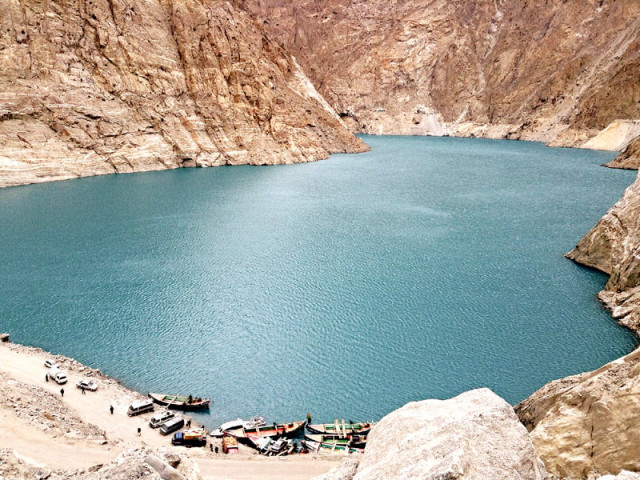Attabad Lake: Teardrop miracle
The Attabad Lake is a glorious reminder that there can be beauty in tragedy.

The Attabad Lake was formed following a massive landslide in 2010, which buried 20 people beneath it and blocked the flow of River Hunza, creating a natural dam. The water has displaced thousands of people and inundated over 19 kilometres of the Karakoram Highway. PHOTO: FRIDA KHAN
Ansoo lake in Kaghan is believed to have been created from tears of jealousy shed by Deuo Sufaid, the white giant, when he learnt that Badr Jamal, the fairy princess he was in love with, had chosen to marry Prince Saiful Mulook. Attabad Lake in Hunza, however, was born of less romantic circumstances. In January 2010, a massive landslide blocked the flow of River Hunza, creating a natural dam and burying 20 people beneath it. The rising water displaced thousands of residents and submerged countless villages, fields, orchards a well as a 19-kilometre stretch of the Karakoram Highway (KKH). In 2012, a spillway was created to release a steady flow of water and as the water receded, it revealed the villages that had been buried beneath. It is only now that people have started returning to rebuild their homes and lives.

Passenger boats ferry people, their belongings and even cars from one side to the other, all through the day. Traffic is prohibited after dusk, and it becomes almost impossible to travel in winter when the lake freezes over. PHOTO: FRIDA KHAN
The KKH is also being rebuilt. A new connection is being carved into the mountains around the lake. The highway begins in Abbotabad, runs through the mountain ranges of Gilgit-Baltistan, crossing over the Chinese border at Khunjerab and into China up to Kashgar. Reaching an elevation of 4,693 metres (15,397 ft), it is the highest paved international highway in the world. During its 20 years of construction, from 1959 to 1979, approximately 810 Pakistanis and 200 Chinese workers lost their lives mostly in landslides and falls.

People have started rebuilding their homes and returning. They hope that once the road connection is restored, life will become better with easier access to work, education and health facilities. PHOTO: FRIDA KHAN
The reconstruction work is also being done by Chinese companies. Pakistani labourers work under the supervision of Chinese engineers in trying circumstances. The strong, howling gusts of wind often whip up dust, sand and tiny stones that sting the workers’ faces and eyes. They do not have a lot of protective gear other than scarves and sunglasses.
Until the connection is restored, the only way to reach the villages of Shishkat, Gulmit, Passu and places onward to the Chinese border is to cross the beautiful, blue lake by boat. Boats ferry people, their belongings and even cars from one side to the other, all through the day. Even the trucks coming from China, carrying material and equipment for the Karakoram Highway construction have to cross the lake on a barge.

Given the importance of the location, work to build a new road and tunnels higher up in the mountains to restore the Silk Route is underway. The reconstruction work is being done by Pakistani labourers under the supervision of Chinese companies. PHOTO: FRIDA KHAN
It’s easy to see how, once the road is functional, this place will become dotted with food points, restaurants and resorts. Tour guides will narrate the story of how the mountain fell and buried 20 people beneath it. Facts will become a story and the story will become a legend. The 20 people might become 20 suitors coming to win the hand of the princess of Gulmit, whose loud collective wail on finding out that she has already been betrothed, brought down the trembling mountains, while their tears flew into the crater and became a bottomless blue lake. If the tale takes a more contemporary twist, they might become 20 brave village women who encircle the mountain to stop evil corporations mining for the jewels beneath, who blast the mountain anyway and end up burying the women underneath.

The Karakoram Highway (KKH) is too important a connection to be left buried in the water. It was built by the governments of Pakistan and China with work starting in 1959 and completed in 1979 (open to the public since 1986).The route of the KKH traces one of the many paths of the ancient Silk Road and is sometimes referred to as the eighth wonder of the world. PHOTO: FRIDA KHAN
But by some miracle, the stone melts and flows past the miners and out of the corporation’s greedy hands, forming a lake of liquid lapis. Whatever form the story takes, they will be remembered. And like Shiva’s sorrow and Deou Sufaid’s heartache, it will perhaps explain why it is that when we see something of great beauty we sometimes feel like crying — while the heart leaps with joy, a tear springs to the eye.
Frida Khan is a project manager at the International Labour Organization Office in Islamabad, Pakistan. She tweets @frida.khan
Published in The Express Tribune, Sunday Magazine, May 25th, 2014.



















COMMENTS
Comments are moderated and generally will be posted if they are on-topic and not abusive.
For more information, please see our Comments FAQ